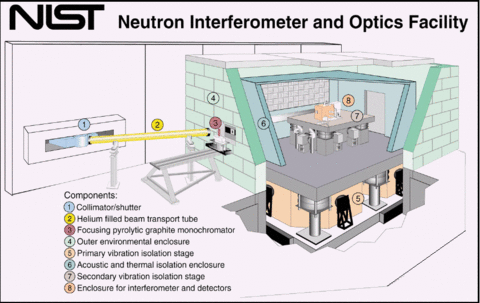Neutron Interferometry and Optics Facility (NIOF)

The Neutron Interferometry and Optics Facility (NIOF) located in the NIST Center for Neutron Research Guide Hall is one of the world's premier user facilities for neutron interferometry and related neutron optical measurements. A neutron interferometer (NI) splits, then recombines neutron waves. This gives the NI its unique ability to experimentally access the phase of neutron waves. Phase measurements are used to study the magnetic, nuclear, and structural properties of materials, as well fundamental questions in quantum physics. Related, innovative neutron optical techniques for use in condensed matter and materials science research are being developed.
The Facility
Neutrons are extracted from a dual-crystal parallel-tracking monochromator system, providing neutron energies in a range of 4 meV to 20 meV. Neutrons are counted with integrating 3He detectors or by high resolution position-sensitive detectors (with a resolution better than 50 µm). The sensitivity of the apparatus is greatly enhanced by state-of-the-art thermal, acoustical and vibration isolation systems. To reduce vibration, the NIOF is built on its own foundation, separate from the rest of the building. The position of the NI is maintained to high precision by a computer-controlled servo system. The result is a NI facility with exceptional phase stability and fringe visibility.
Materials Science Applications
Neutron interferometry is ideal for making accurate measurements of the nuclear scattering properties of elements and isotopes. This is especially useful for the non-destructive determination of the hydrogen content in materials. NI can also directly measure the Fourier Transform of the neutron momentum distribution, which can used for precision studies of the surface properties of materials. Development of neutron imaging techniques with real-world applications is a major emphasis of the facility. In particular, neutron phase contrast imaging, three-dimensional neutron tomography, and single crystal diffractometers are being developed for the study of structural and bulk properties of materials. These instruments and techniques will be valuable for materials science research and industrial applications.
Fundamental Physics Applications
The NI is the only device that gives direct access to the phase of neutron waves. This ability has long been utilized to investigate fundamental problems in quantum mechanics. Important experiments such as the 4π spinor rotation of fermions and gravitationally induced quantum interference have been carried out. This important basic research continues at the NIOF. Experiments such as a Wheeler Delayed-Choice experiment and a precision measurement of the Aharonov-Casher effect are being designed in collaboration with physicists from universities and other research institutions.
Specifications/Capabilities
Instrument Parameters
- Interferometer:
- Single crystal silicon
- Monochromator:
- Pyrolytic graphite
- Neutron Energy:
- 4 meV to 20 meV
- Fringe Visibility (Contrast):
- > 70%
- Phase Stability:
- < 5 · 10-3 rad/day
- Vibration Isolation:
- < 1 · 10-7 g
- Position Stability:
- 2 µm in translation
- 1 µrad in rotation
- Temperature Stability:
- 0.1 °C/day
Scientific Opportunities/Applications
Materials Science and Solid State Physics Applications
- Neutron phase contrast imaging
- Neutron tomography
- Small angle neutron scattering studies with perfect crystals
- Determination of hydrogen content in materials
- Neutron Fourier Spectroscopy for surface studies
- Phase transition studies
- Measurement of bound coherent scattering length
Fundamental Physics Applications
- Spinor nature of fermions
- Gravitational quantum interference
- Measurement of longitudinal coherence length of neutrons
- Sagnac effect on the neutron phase
- Aharonov-Casher effect

